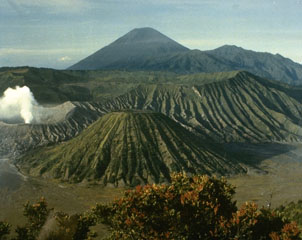Report on Tengger Caldera (Indonesia) — 13 March-19 March 2019
Smithsonian Institution / US Geological Survey
Weekly Volcanic Activity Report, 13 March-19 March 2019
Managing Editor: Sally Sennert.
Please cite this report as:
Global Volcanism Program, 2019. Report on Tengger Caldera (Indonesia) (Sennert, S, ed.). Weekly Volcanic Activity Report, 13 March-19 March 2019. Smithsonian Institution and US Geological Survey.
Tengger Caldera
Indonesia
7.942°S, 112.95°E; summit elev. 2329 m
All times are local (unless otherwise noted)
PVMBG reported that during 1 January-17 March plumes rising from Tengger Caldera’s Bromo cone were generally white to gray in color, had variable densities, and rose no higher than 700 m above the crater rim. Tremor signals increased on 10 March and were accompanied by changes in the color and height of the emissions. On 16 March a dense gray ash plume rose 1.5 km and drifted E, causing ashfall in areas both inside and outside the caldera. Two seismic signals indicating explosions were recorded around 1547 on 17 March. Periods of continuous ash emissions were observed during 17-18 March, with ash plumes rising as high as 1.2 km above the crater rim and drifting NE, N, NW, and W. At 1020 on 19 March a black ash plume rose 1.5 km and drifted E and NE. The Alert Level remained at 2 (on a scale of 1-4).
Geological Summary. The 16-km-wide Tengger caldera is located at the northern end of a volcanic massif extending from Semeru volcano. The massive volcanic complex dates back to about 820,000 years ago and consists of five overlapping stratovolcanoes, each truncated by a caldera. Lava domes, pyroclastic cones, and a maar occupy the flanks of the massif. The Ngadisari caldera at the NE end of the complex formed about 150,000 years ago and is now drained through the Sapikerep valley. The most recent of the calderas is the 9 x 10 km wide Sandsea caldera at the SW end of the complex, which formed incrementally during the late Pleistocene and early Holocene. An overlapping cluster of post-caldera cones was constructed on the floor of the Sandsea caldera within the past several thousand years. The youngest of these is Bromo, one of Java's most active and most frequently visited volcanoes.
Source: Pusat Vulkanologi dan Mitigasi Bencana Geologi (PVMBG, also known as CVGHM)

